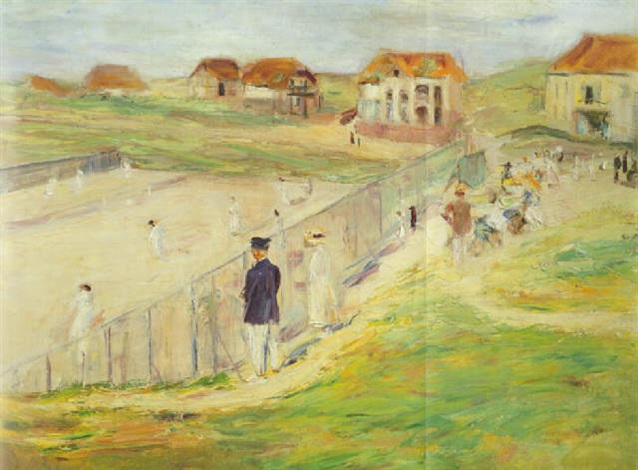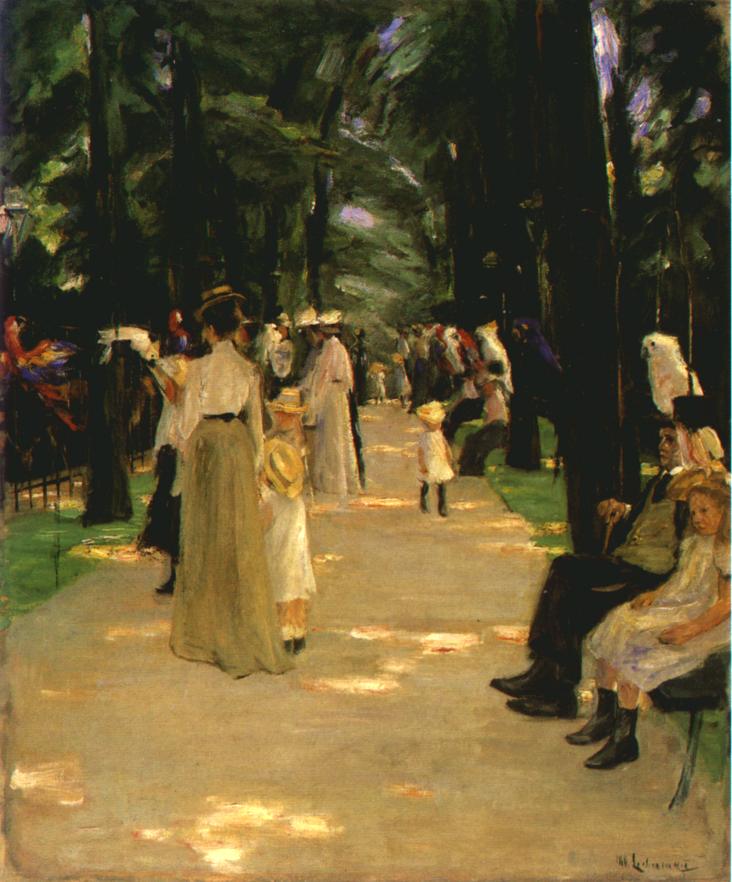Kunsthalle Bremen
22 October 2016 to 26 February 2017
Liebermann Villa am Wannsee, Berlin
19 March to 26 June 2017
Liebermann Villa am Wannsee, Berlin
19 March to 26 June 2017
Today, the world of sports penetrates almost every aspect of life. It is a critical element of modern lifestyle, a popular spectacle for the masses or an expression of social distinction. In Germany, the incredible success story of sports began more than a hundred years ago: Max Liebermann was the first German artist to preoccupy himself extensively with this subject.
The exhibition examines Liebermann’s preoccupation with leisure, recreation and sports within the context of art as well as the historical and social development of sport, with a special focus on horse riding, polo and tennis in art. Works by Degas, Manet and Toulouse-Lautrec illustrate the inspiration that Liebermann found in French painting and graphic arts. However, his depictions of tennis and polo players are unique in France and Germany.
The singularity of his motifs is illustrated through the juxtaposition with selected works by English and German contemporaries such as John Lavery and Max Slevogt. Liebermann primarily explores the subjects of horseback riding, tennis and polo motifs in the period between 1900 and 1914. These works convey an image of the Wilhelminian upper classes whose leisure activities were infused by the idea of the English sportsman.
At the end of the nineteenth century, Liebermann turned his attention to summer visitors at the North Sea. There he first painted bathers and horseback riders but soon focused on modern sports such as polo, horse racing and tennis which had been popular in England for some time.
Following the First World War, Liebermann’s sports motifs faded into the background. In the 1920s a younger generation of artists began to discover sports as a subject, particularly sports for the masses such as football and boxing.
Depictions of boxers by Willy Jaeckel, Renée Sintenis and Rudolf Grossmann reflected the change in interest from elegant lawn sports in the countryside to physical exertion in urban sports arenas.
The exhibition will present about 140 works from international museums and private collections from Washington, Jerusalem, Paris and Zurich as well as from the collection of the Kunsthalle Bremen.
The exhibition examines Liebermann’s preoccupation with leisure, recreation and sports within the context of art as well as the historical and social development of sport, with a special focus on horse riding, polo and tennis in art. Works by Degas, Manet and Toulouse-Lautrec illustrate the inspiration that Liebermann found in French painting and graphic arts. However, his depictions of tennis and polo players are unique in France and Germany.
The singularity of his motifs is illustrated through the juxtaposition with selected works by English and German contemporaries such as John Lavery and Max Slevogt. Liebermann primarily explores the subjects of horseback riding, tennis and polo motifs in the period between 1900 and 1914. These works convey an image of the Wilhelminian upper classes whose leisure activities were infused by the idea of the English sportsman.
At the end of the nineteenth century, Liebermann turned his attention to summer visitors at the North Sea. There he first painted bathers and horseback riders but soon focused on modern sports such as polo, horse racing and tennis which had been popular in England for some time.
Following the First World War, Liebermann’s sports motifs faded into the background. In the 1920s a younger generation of artists began to discover sports as a subject, particularly sports for the masses such as football and boxing.
Depictions of boxers by Willy Jaeckel, Renée Sintenis and Rudolf Grossmann reflected the change in interest from elegant lawn sports in the countryside to physical exertion in urban sports arenas.
The exhibition will present about 140 works from international museums and private collections from Washington, Jerusalem, Paris and Zurich as well as from the collection of the Kunsthalle Bremen.
Key visual of the Exhibition
Max Liebermann Tennisspieler am Meer, first version, 1901 Oil on canvas 69,5 x 100,3 cm Museum Kunst der Westküste, Alkersum, Föhr © Repro Lukas Spörl
Horseriding, Polo and Horseracing
Max Liebermann Reiter am Strand mit Foxterrier, 1911 Oil on canvas 70 x 100 cm Nationalmuseum Stockholm
Max Liebermann Reiter und Reiterin am Strand, 1903 Oil on canvas 72,5 x 101 cm Wallraf-Richartz-Museum & Fondation Corboud, Köln, Photo: Rheinisches Bildarchiv Köln, rba_c016036
Max Liebermann Polospieler in Jenischs Park, 1903 Oil on canvas 71 x 102 cm Private collection
Max Liebermann Pferderennen (in den Cascinen), 2. version, 1909 Oil on wood 52 ,5 x 74 cm Kunstmuseum Winterthur, present by Georg Reinhart, 1924 © Schweizerisches Institut für Kunstwissenschaft, Zürich, Jean-Pierre Kuhn
Henri de Toulouse-Lautrec Der Jockey, 1899 Lithography 51,4 x 36,1 cm Sammlung Hegewisch in der Hamburger Kunsthalle
Tennis
Max Liebermann Tennisplatz in Noordwijk, 1911 Oil on canvas 64 x 78 cm Private collection
Other Leisure Activities
Max Liebermann Nach dem Baden, 1904 Oil on canvas 62,9 x 91,1 cm Tate, London, legacy G.L. Tietz 1980 © Tate, London 2016
Max Liebermann Schlittschuhläufer im Tiergarten, 1923 Oil on canvas 39,5 x 50 cm Private collection
Max Liebermann Papageienallee, 1902 Oil on canvas 88,1 x 72,5 cm Kunsthalle Bremen – Der Kunstverein in Bremen, Photo: Lars Lohri
Max Liebermann Tennisspieler am Meer, first version, 1901 Oil on canvas 69,5 x 100,3 cm Museum Kunst der Westküste, Alkersum, Föhr © Repro Lukas Spörl
Horseriding, Polo and Horseracing
Max Liebermann Reiter am Strand mit Foxterrier, 1911 Oil on canvas 70 x 100 cm Nationalmuseum Stockholm
Max Liebermann Reiter und Reiterin am Strand, 1903 Oil on canvas 72,5 x 101 cm Wallraf-Richartz-Museum & Fondation Corboud, Köln, Photo: Rheinisches Bildarchiv Köln, rba_c016036
Max Liebermann Polospieler in Jenischs Park, 1903 Oil on canvas 71 x 102 cm Private collection
Max Liebermann Pferderennen (in den Cascinen), 2. version, 1909 Oil on wood 52 ,5 x 74 cm Kunstmuseum Winterthur, present by Georg Reinhart, 1924 © Schweizerisches Institut für Kunstwissenschaft, Zürich, Jean-Pierre Kuhn
Henri de Toulouse-Lautrec Der Jockey, 1899 Lithography 51,4 x 36,1 cm Sammlung Hegewisch in der Hamburger Kunsthalle
Tennis
Max Liebermann Tennisplatz in Noordwijk, 1911 Oil on canvas 64 x 78 cm Private collection
Other Leisure Activities
Max Liebermann Nach dem Baden, 1904 Oil on canvas 62,9 x 91,1 cm Tate, London, legacy G.L. Tietz 1980 © Tate, London 2016
Max Liebermann Schlittschuhläufer im Tiergarten, 1923 Oil on canvas 39,5 x 50 cm Private collection
Max Liebermann Papageienallee, 1902 Oil on canvas 88,1 x 72,5 cm Kunsthalle Bremen – Der Kunstverein in Bremen, Photo: Lars Lohri









